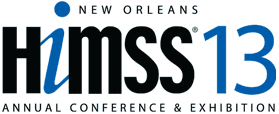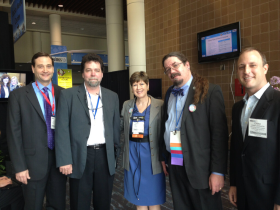Health Data Tell the Story at HIMSS13
 Wednesday, March 13, 2013 at 4:39PM
Wednesday, March 13, 2013 at 4:39PM 
The overarching theme I drew from HIMSS13 is that we’re in the early stages of understanding how to utilize health data for the benefit of patients. Keynoter Eric Topol drove this point home by dubbing the “show me the money” scene in Jerry Maguire with “show me the data”: http://e-patients.net/archives/2013/03/show-me-the-data-eric-topol-rocks-the-himss13-keynote.html. Take a look; it’s worth the 1.25 minutes.
Another keynoter, former President Bill Clinton, spoke of how he developed the talent for storytelling growing up in Arkansas without television in his early years. Frankly, I think Clinton would have been a gifted storyteller with or without access to television. I summarized Clinton speech in the following tweet:
@janicemccallum: Lack of #transparency and policies & systems that disempower ordinary people need to change were key themes of Clinton’s keynote at #HIMSS13
Obviously, a single tweet can’t replicate a well-crafted story delivered by a master, but let’s highlight his use of the word “disempower” to describe how patients are treated in the current US healthcare system. “Disempower” forcefully describes how our current system leaves patients on their own to navigate a complex and obscure system that can have devastating consequences to ordinary people if they are not able to advocate for themselves.
Conversely, a key theme in the exhibit hall at HIMSS was “patient engagement”. Let’s compare the power of the two terms when trying to appeal to “ordinary people”. Patient engagement strikes me as a term dreamed up by marketing to indicate that hospitals and other providers want to figure out how to convince patients that the providers know best, whereas disempowered conveys the sentiments of so many people once they step inside the door of a hospital. Which term is more likely to rally ordinary people to demand changes in healthcare that allow them to participate in their own care? I’ll let you be the judge.
Another Clinton quote that was tweeted by HIMSS relates more directly to health data:
@HIMSS: Clinton: “Whole promise of #healthIT is to manage data to know what the heck we are doing. You can do it. No pressure.” #HIMSS13
This statement provides a good segue to other themes central to HIMSS. There’s been so much focus on adoption of software and basic standards for the software that the HIMSS crowd has not focused on the critical task of understanding the content that flows through the EHRs and related health IT systems. Meaningful Use Stages 1 and 2 set the foundation for basic population health metrics, but as clinicians and researchers get a taste for how useful secondary data from EHRs can be, I predict an explosion in interest in analytic tools that help harness and mine health data and an overall maturing of the high-growth highly-fragmented health analytics segment.
At present, we’ve just touched the surface of harnessing health data for the benefit of patients. However, I noted good progress in providing patients access to their health records, as required by Meaningful Use at HIMSS. Recently, a colleague of mine was thrilled just to receive a visit summary from her doctor. After all, this is the first time most of us have received anything in writing from our doctors, with the exception of patient handouts written by Pharma companies or a scrawled Rx to take to the pharmacy. Having access to a more complete history of visits and lab test results is orders of magnitude more powerful than verbal communication in helping patients learn from their health data. To those who say that patients don’t have the ability to understand the information in their health record, my retort at HIMSS was “people love reading about themselves” and are more likely to invest time in understanding data about themselves than they would a generic label insert or patient handout.
 Janice surrounded by HITsm Tweetchat participants Jon Mertz, Michael Planchart, Keith Boone, and Chad Johnson at HIMSS13
Janice surrounded by HITsm Tweetchat participants Jon Mertz, Michael Planchart, Keith Boone, and Chad Johnson at HIMSS13
On a related note, I participated in a live Tweetchat at HIMSS where my topic was:
How can patient-generated data influence medical care, research and patient engagement?
I chose this topic to open up a discussion of what the future may hold as all stakeholders gain experience and learn how to interpret new sources of data. I was pleased that one of the MDs in the audience supported my view that patient registries and patient reported data represent rich new information sources for medical research that can supplement today’s “gold standard” of randomized controlled clinical trials. See: http://www.hl7standards.com/blog/2013/03/06/in-case-you-missed-it-video-of-the-live-hitsm-chat-courtesy-of-hibc-tv/ starting at 5:40 minutes for my segment of the discussion. [Note, I’m not @motorcycleguy on Twitter. In fact, neither is Keith Boone, who precedes me in this video. It should be @motorcycle_guy. Slight typo on my Twitter handle, too. I’m @janicemccallum.]
To sum up my HIMSS 2013 story, I agree with several other analysts & pundits (e.g., Andy Oram, John Moore, Michael Planchart) who expressed sentiments that there was no awe-inspiring technology or great leap forward exhibited at HIMSS this year. In my view, 2013 is a transition year where the focus shifts from technology to data. Remember, after all, the “IM” in HIMSS stands for Information Management. It has taken a long time to build the basic infrastructure for health IT—and we still have many interoperability and usability issues to work out—but we have a foundation on which we can start building business intelligence/analytic models.
So what does this mean for the health IT vendors? One easy prediction: there will be a slew of alliances and acquisitions between healthIT vendors and analytics firms in the coming year or two.


Reader Comments